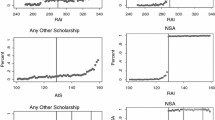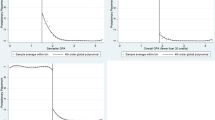Abstract
This paper examines the factors influencing theyield — the proportion of accepted applicants that confirm their intention to attend — in the admissions process for the MBA program of the school of management at a large metropolitan university. A stochastic model of a student's MBA program choice decision is presented. Using the resulting logistic probability model, the authors examine the impact of student traits (both aptitude-related and non-aptitude-related) and program characteristics, known to admissions officials, on the probability of confirmation. The results of the analysis provide a basis for measuring the dimensions of the market for educational services this MBA program provides, suggest a strategic response to this market, and offer a way to measure the profitability of various strategic response options. In particular, the results demonstrate that financial aid awards can increase dramatically the probability of confirmation and that confirmation probabilities are affected significantly by non-aptitude-related student characteristics.
Similar content being viewed by others
References
Anderson, C. A., Bowman, M. J., and Tinto, V.Where Colleges Are and Who Attends. New York: McGraw-Hill, 1972.
Anderson, J. A. Logistic discrimination with medical applications. In T. Cacoullos (Ed.),Discriminant Analysis and Applications. New York: Academic Press, 1973, pp. 1–16.
Barron's Profiles of American Colleges (Vol. 1). 12th edition. Woodbury, N.Y.: Barron's Educational Series, 1980.
Campbell, R., and Siegal, B. The demand for higher education in the United States, 1919–1964.American Economic Review 1967,57 482–494.
Chapman, R. G.Buyer Behavior in Higher Education: An Analysis of College Choice Decision Making Behavior. Doctoral dissertation, Graduate School of Industrial Administration, Carnegie-Mellon University, 1977.
Chapman, R. G. Pricing policy and the college choice process.Research in Higher Education 1979,10 37–57.
Cox, D. R. Some procedures associated with the logistic qualitative response curve. In F. N. David (Ed.),Research Papers in Statistics: Festschrift for J. Neyman. London: John Wiley, 1966.
Day, N. E., and Kerridge, D. F. A general maximum likelihood discriminant.Biometrics 1967,23 313–323.
Domencich, T., and McFadden, D.Urban Travel Demand. Amsterdam: North-Holland, 1975.
Fram, E. H. Marketing higher education. In D. W. Vermilge (Ed.),The Future in the Making. San Francisco: Jossey-Bass, 1973.
Galper, H., and Dunn, R. M., Jr. A short-run demand function for higher education in the United States.Journal of Political Economy 1969,77 756–777.
Gorman, W. P. Marketing approaches for promoting student enrollment in higher educational institutions.College and University 1974,49 242–250.
Hise, R. T., and Smith, E. P. Using cognitive dissonance theory to reduce the backout rate in school of business applications.Decision Sciences 1977,8 300–310.
Kohn, M. G., Manski, C. F., and Mundel, D. S. An empirical investigation of factors which influence college-going behavior.Annals of Economic and Social Measurement 1976,5 391–419.
Kotler, P. Applying marketing theory to college admissions.A Role for Marketing in College Admissions. Princeton, N.J.: College Entrance Examination Board, 1976, pp. 54–72.
Kotler, P., and Dubois, B. Education problems and marketing. In J. N. Sheth and P. L. Wright (Eds.),Marketing Analysis for Societal Problems. Urbana-Champaign, Ill.: Bureau of Economic and Business Research, College of Commerce and Business Administration, University of Illinois, 1974, pp. 186–204.
Krachenberg, A. R. Bringing the concept of marketing to higher education.Journal of Higher Education 1972,43 369–380.
Luce, R. S.Individual Choice Behavior: A Theoretical Analysis. New York: John Wiley, 1959.
Luce, R. D., and Suppes, P. Preference, utility, and subjective probability. In R. D. Luce, R. A. Bush, and E. Galanter (Eds.),Handbook of Mathematical Psychology (Vol. 1). New York: John Wiley, 1965, pp. 249–410.
McFadden, D. Analysis of qualitative choice behavior. In P. Zarembka (Ed.),Frontiers in Econometrics. New York: Academic Press, 1974, pp. 105–142.
McFadden, D. A comment on discriminant analysis “versus” logit analysis.Annals of Economic and Social Measurement 1976,5 511–523.
Pindyck, R., and Rubinfield, D.Econometric Models and Economic Forecasts (2nd ed.). New York: McGraw-Hill, 1981.
Punj, G. N., and Staelin, R. The choice process for graduate business schools.Journal of Marketing Research 1978,15 588–598.
Radner, R., Miller, L. S., Adkins, D. L., and Balderston, F. E.Demand and Supply in U.S. Higher Education. New York: McGraw-Hill, 1975.
Stork, D., and Berger, P. Attrition in the liberal arts college of a major metropolitan university.Research in Higher Education 1979,9 281–289.
Tuckman, H. P. College presence and the selection of college.Land Economics 1971,47 198–205.
Author information
Authors and Affiliations
Rights and permissions
About this article
Cite this article
McClain, D., Vance, B. & Wood, E. Understanding and predicting the yield in the MBA admissions process. Res High Educ 20, 55–76 (1984). https://doi.org/10.1007/BF00992035
Received:
Issue Date:
DOI: https://doi.org/10.1007/BF00992035




